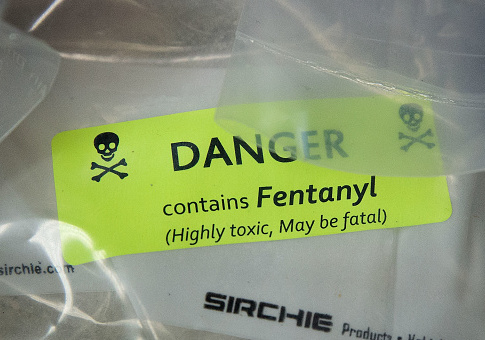A new Drug Enforcement Agency (DEA) office on the front lines of the opioid crisis will aim to tackle exploding drug overdose death rates and Mexican drug trafficking, according to its chief-in-waiting, DEA agent D. Christopher Evans.
Evans, who currently serves as Associate Special Agent in Charge of the Detroit field office, will move up to the role of Special Agent in Charge of the DEA's new Louisville division. That office, which was announced earlier this month, will be the 22nd field office in the DEA's network. It will combine DEA operations in the states of Kentucky, West Virginia, and Tennessee, all of which were previously under the auspices of other field offices.
Evans, a 25-year veteran of the DEA, joined the Detroit field office—which previously oversaw DEA operations in Kentucky—in September. Prior to that, he spent much of his career in Los Angeles, working as an agent and a supervisor and dealing with the drug war on the border. He also did stints at DEA headquarters, at the Mexico/Central America desk, and working for the head of the agency.
Evans's work in Louisville and the Detroit field office has presented markedly different challenges from those he faced working on the border, he told the Free Beacon. On the border, he explained, he "would have been looking more at direct contact with the sources, and trying to stem the flow as it comes into the country."
"[In Louisville], what we're trying to do is make sure that we can really make an impact with protecting the community," Evans said. "That's what it's all about in terms of what's done in the region, is really what we do to stop the threat to the community, what we do to make sure the people that are trying to prey on the community don't have the opportunity to do that."
That community, the Appalachian states for which Evans now finds himself responsible, has been particularly hard hit by the surging opioid crisis. According to the Centers for Disease Control and Prevention, West Virginia and Kentucky had the highest and third-highest per capita rate, respectively, of drug overdose death in 2015; Tennessee was tenth.
Those overdose deaths are driven in large part by heroin and fentanyl, both of which are distributed by Mexican drug cartels. As journalist Sam Quinones has extensively documented, these cartels have innovated by expanding the market for opioids out of more traditional cities and into America's blighted rural and suburban areas. The result is an extensive Mexican drug trade—and concurrent spiraling drug deaths—in many states.
"What we're seeing in the region is more and more of our investigations focus on heroin trafficking, and we've seen more instances of Mexican-based sources of supply sending heroin and meth directly from Kentucky and the region," Evans said. "We really have had an uptick in what we've seen in our investigations in terms of the source of supply being Mexico-based, and operating deliveries from California directly into the area. And that's something which has changed in the last few years."
The cartels continue to use practiced techniques for trafficking their wares: drivers, the mail service, and small-time couriers. The real challenge, Evans explained, is that the cartels have figured out how to target new, vulnerable markets.
"What has changed is, they are increasingly focusing on this area as a place to seek profits," Evans explained. "It's not that their methodologies have changed so much, as they continue to be imaginative in the ways that they will try to smuggle things in. What we think is different is that the volume of what they're doing in this region is different, and their focus on trying to make a profit out of the people who we're here to serve, is what’s different."
Simultaneously, the potency of the drugs being distributed has increased dangerously. The super-potent opioid fentanyl, 50 to 100 times more powerful than morphine, is increasingly prevalent; so too is its even more powerful analog carfentanil, which is used by veterinarians as an elephant tranquilizer. U.S. Customs and Border Protection reported seizing 1,485 pounds of fentanyl in 2017, up from two pounds seized in 2014.
Evans explained that fentanyl and carfentanil are growing more prevalent in the Appalachian region as well, and that they are being mixed not only with heroin but also with methamphetamines. Fentanyl was the number one cause of drug overdose death in 2016.
All of this helps explain the creation of the new Louisville field office, which will allow the DEA to hit back at the opioid epidemic where it is most highly concentrated. A centralized office will allow for more effective coordination between law enforcement stakeholders, especially within the context of the DEA's High Intensity Drug Trafficking Area (HIDTA) program, which facilitates cooperation between federal, state, and local authorities.
Evans noted that there have already been successes, on top of which the Louisville office will build. In October, the DEA announced six new enforcement teams to combat heroin and fentanyl: one will go to West Virginia. Evans also touted successes working with Louisville police and the U.S. Attorney's office in a number of successful drug prosecutions.
Evans emphasized the need to address the drug crisis from a holistic perspective, following the DEA's 360 strategy to enable treatment and prevention alongside law enforcement. Those three prongs will all be pointed at one target: opioid abuse.
"What we look to do is to focus our efforts on to really benefit the community, and right now the biggest threat to the community is the opioid crisis, and that's where we’re going to focus our attention. That does not mean we'll ignore other things, but we will focus our attention on how we best impact the community to help with the opioid crisis," Evans said.
